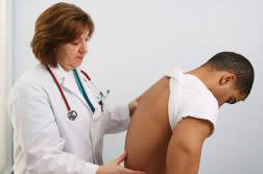 Spinal stenosis is a condition where the spinal canal is narrowed. The term "stenosis" comes from Greek and means "choking." In layman's terms, it means narrowing of the spinal canal is choking the spinal cord or nerve. The spinal canal is the central canal that travels through the entire length of the spinal column which the spinal cord descends, and there are secondary holes to each side of the canal to allow emergence of spinal nerves at each level.
Spinal stenosis is a condition where the spinal canal is narrowed. The term "stenosis" comes from Greek and means "choking." In layman's terms, it means narrowing of the spinal canal is choking the spinal cord or nerve. The spinal canal is the central canal that travels through the entire length of the spinal column which the spinal cord descends, and there are secondary holes to each side of the canal to allow emergence of spinal nerves at each level.
The skull, vertebral column of the spine, and sacrum (at the bottom of the spine) serve to support the structures of the body and to protect the delicate brain, spinal cord, and nerves beneath. Each of these bony structures has holes through which nerves pass outward to the major parts of the body.
The spinal cord stops at the upper part of the lower back. Below that, the tiny contained nerve rootlets descend loosely splayed out – like a horse’s tail – and protectively enclosed in a long sack. All central nerve structures are protected further by membranes, with the outer membrane called the dura (tough) mater (mother).
In lumbar spinal stenosis, the spinal cord or spinal nerve roots are compressed. When nerves are compressed they can produce symptoms of pain, numbness, and tingle in the legs with activity. In rare cases, it can produce severe pain and even weakness. Most cases will produce pain in the legs with walking, and the pain will be relieved by sitting.
Spinal stenosis can occur in a variety of ways in the spine. Approximately 75% of cases of spinal stenosis occur in the low back (lumbar spine), and most will affect the sciatic nerve which runs along the back of the leg.
The cause is related to degeneration of the spine and will become significant in the 5th decade of life and extend throughout every subsequent age group. Arthritis (especially osteoarthritis) is a common cause of spinal stenosis. As people age, the ligaments of the spine may thicken and calcify, bones and joints may enlarge, and osteophytes (bone spurs) may form.
Facet joints tend to get larger as they degenerate. This process is the body’s attempt to decrease the stress per unit area across a degenerated joint. Unfortunately, as the joint enlarges, it can place pressure on the nerves as they exit the spine. Tumors of the spine (causing inflammation or growth directly into the spinal canal), trauma (causing fractures or dislocation of the spine), tissue swelling after surgery, Paget’s disease, and fluorosis (excessive level of fluoride in the body causing calcified spinal ligaments or softened bones leading to degenerative conditions) can also cause spinal stenosis.
Standing upright further decreases the space available for the nerve roots, and can block the outflow of blood from around the nerve. Congested blood then irritates the nerve and the pain travels into the legs.
Generally, patients with spinal stenosis are comfortable if they are sitting, but have more pain down their legs when they walk.
Spine surgery (an open decompression or laminectomy) is the only way to change the anatomy of the spine and give the nerves more room. Decompressing the nerves by removing a portion of the enlarged facet joint prevents the nerve pinching when the patient stands up. It is effective in approximately 80% of cases, although over a 5-year period of time the results tend to deteriorate.
Manual techniques and acupuncture with modalities can be utilized to relieve significant pain and discomfort arising from secondary soft tissue tightness and muscle spasms. Incorporating acupuncture is remarkably effective in providing successful pain relief. Although electrical stimulation is commonly used in conventional therapy to reduce pain and relax soft tissue, the inclusion of acupuncture needles allows the stimulation to penetrate deeper and affect the involved structure directly.
A well-trained physical therapist recognizes poor postural alignment as a predisposing factor to various muscular and skeletal conditions. With spinal stenosis, a posterior (backward) tilt of the hips will reduce lumbar lordosis (inward curve in lower back) and subsequently relieve symptoms, especially with standing and walking activities.
Conditions Treated
-
- Bursitis
- Carpal Tunnel Syndrome
- Chronic Fatigue Syndrome
- Circulation
- Fibromyalgia
- Foot & Heel Pain
- Frozen Shoulder
- Herniated Disk
- Lower Back Pain
- Lumbar Spinal Stenosis
- Migraines
- Neck Pain
- Osteoarthritis
- Peripheral Neuropathology
- Piriformis Syndrome
- Poor Posture
- Rheumatoid Arthritis
- Rotator Cuff
- Sciatica
- Shingles
- Sinusitis
- Tennis Elbow
- TMJ